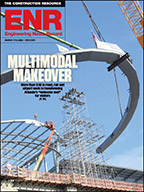Turkish Firm Nabs $1.9B Rail Contract in Tanzania

Tanzania's overall standard-gauge rail program is divided into five sections, called lots. Map courtesy of Yapi Merkezi
Turkish contractor Yapi Merkezi late last month signed a $1.9-billion turnkey contract for the construction of 368 kilometers of electrified standard gauge railway (SGR) in Tanzania comprising all infrastructure works and the materials and systems for the trackwork, catenary power supply, signaling and telecommunications.
This is the third construction contract for the firm, which holds two other contracts for the overall SGR project—the 300-km Phase One connecting East Africa’s second biggest port of Dar es Salaam to Morogoro and the 426-km. Phase Two linking Morogoro to Makutupora. Phase 3 of the railway line is the third of five in the construction of a 1,219-km line linking Tanzania to neighboring countries, including Rwanda, Burundi and Uganda. “We are expecting to commence construction within the first quarter of 2022,” said Başar Arıoğlu, chairman of Yapı Merkezi Construction and Industry, the flagship of the Yapi Merkezi Group and Yapı Merkezi Holding.
This portion of the SGR line links Makutupora and Tabora with seven stations at Manyoni, Itigi, Tura, Malongwe, Goweko, Igalula and Tabora. The SGR trains will travel as high as160km/hr.
“Decorative elements obtained from Tanzania’s rich and colorful culture will be reflected in the design of station exteriors and interiors. Such cultural elements will also be used in visible sections of the line, such as viaducts and bridges,” says Arıoğlu.
The line, which will be constructed over a 46-month period, will increase Tanzania’s total investment in the SGR network to $6.3 billion.
Basar says the SGR line will handle higher axle loads and faster speeds and significantly increase the transportation capacity along the alignment, resulting in reduced costs for cargo and faster and comfortable rides for passengers.
“Most importantly, reduced carbon emissions will protect the world-renowned natural treasures of Tanzania and as a continuation of the previous two lots of the SGR, cargo trains will help decongest of the port of Dar es Salaam by ensuring goods that arrive at the port are moved towards destinations inland without delays and with ease,” he added.
Tanzania President Samia Suluhu Hassan has stated that her government is unable to finance the huge railway project using domestically generated revenues, and is pushing for concessional loans to finance a total of 2561 km of the SGR network concurrently with the improvement of the existing meter gauge line, which is narrower. Both lines are running parallel to each other.
Arıoğlu says the third phase passes through a terrain that is “mainly characterized by smooth topography, excluding the portion from Makutupora to Manyoni with two steep climbing sections with a total length of 30 kilometers.”
“One of the biggest challenges is the unknown regarding the actual topography and geotechnical conditions of the route, which were not fully available to the contractor at the tendering stage,” he adds.
Planning of the drainage and movement of water around the new line is a major engineering challenge and an important factor for the safe operation and durability of the SGR system, Basar notes. “The progress of the works could be affected by such activities as relocations and expropriations that must be carried out according to the principles set out in Environmental and Social Action Plans."



